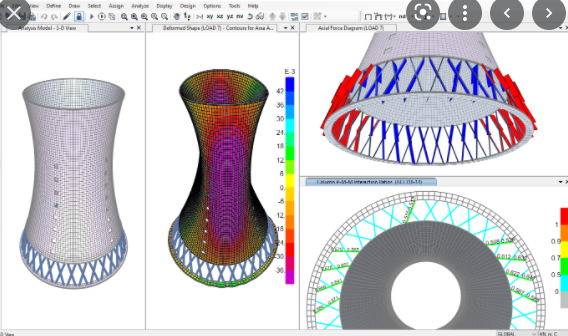To simulate the wave moving through the structure, multi-step static linear loading can also be generated. Dynamic (time-history loaded) loading can be used to simulate the wave moving through the structure. Force Load can be used to apply concentrated forces or moments along with the frame elements and at the joints. The values can be specified in either a fixed or joint local coordinate system. A shell element is an area object used to the model membrane, shell, and plate behavior in planar or three-dimensional structures. The layered shell can also be used to model material nonlinearity.
Sap2000
Password 123
Different Cp coefficients can be used to control wind pressure. Spring supports are link elements used to connect elastic joints to the ground. They can be linear or nonlinear. You can model nonlinear support conditions such as gaps, elastic or plastic springs, viscous dampers, and base isolators. SAP2000 allows for the integration of many structural components. CSI software stores model data, as well as other information, in tables that can be edited via interactive database editing. CSI Software Products – Computer and Structures, Inc. has been recognized as a global leader in structural engineering analysis and software for earthquake and structural engineering design. SAP2000 can generate video (.avi), files that visually present a set of analysis results that differ over time, such as in historical analysis.

ETABS provides a single interface for modeling, analysis, design, reporting, and reporting. There are no limits on the number of model windows, view models, or data views that can be opened. A-frame member can be assigned an auto-select list section. The program will automatically choose the most appropriate, economical section when designing it.
This feature is available in the following ASCE codes: 7-88, 7-95, 7-04, 7-05, and 7-10. The solid element has eight nodes and can be used to model three-dimensional structures or solids. Section Designer, an integrated utility that is part of SAP2000, CSiBridge, and ETABS, allows the creation and analysis of custom cross-sections. Section Designer allows you to evaluate member properties and nonlinear responses, including PMM-hinge and nonlinear hinge behavior. Frame elements use a three-dimensional beam-column formula that includes effects such as biaxial bending and torsion.
Compatible with other BIM-enabled apps, IFC data model support allows for compatibility. SAP2000, CSiBridge and ETABS support IFC 2×3 or IFC 4 formats. FNA, or nonlinear modality, is an extremely efficient and precise method that can handle a variety of problems. Direct integration is even more versatile and can handle large deformations as well as other nonlinear behavior. You can link nonlinear time-history analysis with many other cases that address a wide variety of applications. A single-screen allows users to view load assignments, moment diagrams, deflected forms, design output, and reports. The 64-bit GUI has been updated to allow for faster model manipulation and storage.
Design
This method is very efficient and considers the dynamic behavior of the structure. C, Z, and Hat Sections can be made from cold-formed steel frames. These sections are included in the SAP2000 section database. Interactive design review and extensive overwrite capabilities are just two of the many highlights.
Rigid diaphragms can produce results that are nearly identical to semi-rigid, but with faster computation. Universities can request academic pricing if they wish to install CSI software on-campus computers for student use. A faculty member who has an email address at the university can request academic pricing by submitting a sales inquiry below. Academic licenses cannot be purchased separately from professor licenses. You can set the tabular output to automatically save after analysis is completed. You can increase the number of modes that are allowed per series.
Fully customizable graphic user interface
Nonlinear-static Buckling Analysis considers material nonlinearity and generates buckling response. These results are often more accurate than linear buckling analyses. Nonlinear-static buckling analysis can be performed using the nonlinear layered shell element. This allows users to take into account the plastic behavior of concrete slabs, slabs, and steel plates. SAP2000 automatically generates reports that can be used to present images and data.
Displacement loading is the result of external displacements and support settlement. Displacement loading can be caused by both spring supports and restraints. Structures with large spans or soil conditions that are susceptible to dynamic excitation by multiple support can be considered. Open Structure Wind Loading allows users to adjust wind loads to specific frames.
CSiXCAD is a CSI-developed plug-in for AutoCAD(r), BricsCAD (r), and streamlines drawing production through direct interaction with SAP2000 or ETABS. CSiXCAD allows you to link structural models that are created and maintained in SAP2000 or ETABS with the drawings used for documenting them. CSiXCAD automatically generates a 3D model and a set of drawings. These can be further refined in the CAD software. Section cuts can be used to define the resultant (free-body), forces, and moments at any cut in the structure. Section cuts can take any shape. They can be used for story shears, connecting force calculations, design forces in shear walls, and many other purposes. You can obtain section cut results for any combination of load cases.
Along with staged sequential building analysis, long-term deflections due to shrinkage and creep can be calculated. The time-dependent material properties of materials are calculated using ACI 209R and CEB FIP codes. User-defined curves can be used to calculate creep strains. SAP2000 allows you to apply wind loads automatically to frames, shells, and diaphragms.
The Auto-Select Section Lists are used for steel frames, aluminum frames and cold-formed steel frames. Before you can create an auto-select list, at least two frames sections must be identified. This strain is calculated by adding the material coefficient of thermal expansion to the temperature change of an element.
Sap2000 System Requirements
- RAM: 512 MB
- Operating System: Windows XP/Vista/7/8/8.1/10
- Processor: Intel Dual Core or higher processor
- Hard Disk: 1 GB
